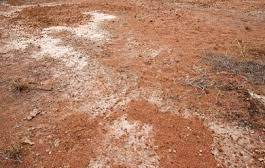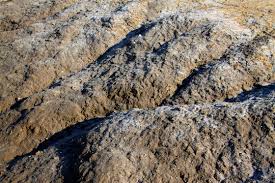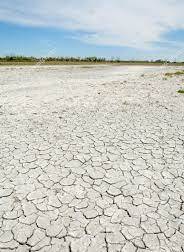Acidic, Saline and Alkaline Soil
Salinity is one of the major factors which affect crop growth and productivity. Excess salt in the soil reduces the water potential of the soil and makes soil solution unavailable to the plants. This effect is also called physiological drought.
What is Salinity?
It is caused by high accumulation of Ca, Mg and Na and then anions such as, SO4, CO3 and HCO3, Cl etc.
What is Sodicity?
It is caused by high accumulation or concentration of Na in the soil.
Acidic Soils
Such soils have pH less than 6.5 and respond to liming. It has following characteristics:
- pH < 6.5
- Soils are open textured with high massive Structure.
- Low in Ca, Mg with negligible amount of soluble salts.
- These soils appear as brown or reddish brown, sandy loams or sands.
Also Read: Download New Aadhaar Card Free Here, Old Aadhaar Card Rejected
Reasons for Acidity
- Humus decomposition results in release of large amounts of acids, which lowers the pH.
- In areas with more than 100 cm rainfall associated with high R.H., Ca, Mg is dissolved in water and leached out due to this base saturation of soil decreases.
- Application of elemental sulphur undergoes reactions resulting in formation of H2SO4.
- Continuous application of acid forming fertilizers like ammonium sulphates or ammonium chlorides results in depletion of Ca.
- Acidic rocks containing large amount of silica (SiO2) when this combined with water, acidity increases.
Effects of Acidity
- On Plants- Root system does not grow normally due to toxic hydrogen ions. Permeability of plant membranes is adversely affected. Enzyme actions may be altered, since they are sensitive to pH changes.
- Nutrients- Deficiency of Ca and Mg occur by leaching. Al, Mn and Fe available in toxic amounts. ‘Mo’ deficiency in leguminous crops. Phosphorous gets immobilized and its availability is reduced.
- Effect on Activity of Microorganisms– Most of the activities of beneficial organisms like Azotobacter and nodule forming bacteria of legumes are adversely affected as acidity increases.
Crops suitable for cultivation in Acidic soil
4.5 citrus, blueberries 5.0 tobacco, apple, plum, grape, watermelon 5.5 cowpea, soyabean, cotton, wheat, oat, pea, tomato, sorghum 6.0 peanut, cabbage, carrot, onion, radish, spinach, cauliflower 6.5 alfalfa, sugarbeet

Amelioration
- Lime– Lime is added to neutralize acidity and to increase the pH, so that the availability of nutrients will be increased.
- Basic slag obtained from Iron and steel industry can be substituted for lime. It contains about 48-54 % of CaO and 3-4 per cent MgO.
- Calcium Ammonium Nitrate (CAN) is suitable to acidic soils. Any citrate soluble phosphate fertilizer is good source of phosphorous for acidic soils. Dicalcium phosphate (DCP), Tricalcium phosphate (TCP). Potassium sulphate is a suitable source of ‘K’ for acidic soils.
Alkaline Soils (Sodic Soil or Black Alkali)
Alkali soils are formed due to concentration of exchangeable sodium and high pH. Sodium carbonate increases alkalinity as a result, the surface soil is discoloured to black; hence the term black alkali is used. Followings are the characteristics:
- Soil pH > 8.5
- Ec < 4.0 m.mhos/cm
- ESP > 15
- It has black colour, hence also called as Black alkali
Reasons for Alkalinity
- The excessive irrigation of uplands containing Na salts caused accumulates of salts.
- In arid and semi-arid areas salt formed during weathering are not fully leached.
- In coastal areas, the ingression of sea water leads to the formation of alkali soils due to formation of sodium carbonates.
- Irrigated soils with poor drainage.
Effects of Alkalinity
- Injury to Crops- High exchangeable sodium decreases the availability of calcium, magnesium to plants.
- Creates nutritional imbalance as a result, growth of plant gets affected.
- Restricted root system and delay in flowering in sensitive varieties.
- Typical leaf burn in annuals and woody plants due to excess of chloride and sodium.
- Toxicity due to excess hydroxyl and carbonate ions.
- Bronzing of leaves in citrus.
- It affects the solubility of zinc (Zn).
- Injury to soil- Dispersion of soil particles due to high exchangeable ‘Na’ leads to poor physical condition of soil, low permeability to water and air, tends to be sticky when wet and becomes hard on drying.

Crops Suitable for Cultivation in Alkaline Soils
Barley, Sugar beet, Cotton, Sugarcane, Mustard, Rice, Maize, Red gram, Green gram, Sunflower, Linseed, Sesame, Bajra, Sorghum, Tomato, Cabbage, Cauliflower, Cucumber, Pumpkin, Bitter guard. Beetroot, Guava, Asparagus, Banana, Spinach, Coconut, Grape, Date palm, Pomegranate.
Amelioration
- To convert exchangeable sodium into water soluble form and leach out the soluble sodium from the field.
- Amendments used for reclamation of Alkali soils.
- Gypsum: It is slightly soluble in water. So it should be applied well in advance.
- Pyrites (FeS2): Sulphur present in pyrites causes decrease in pH of soil due to formation of H2SO4.
- Application of sulphur.
- Application of molasses.
- Incorporation of green manure crops in the field.
Saline Soils (White alkali)
The saline soils contain toxic concentration of soluble salts of chlorides and sulphates of sodium, calcium, magnesium in the root zone. Because of the white encrustation formed due to salts, the saline soils are also called white alkali soils. Followings are the characteristics:
- pH < 8.5
- EC > 4.0 m.mhos/cm
- ESP < 15
- Dominated by sulphate and chloride ions and low in exchangeable sodium
- Flocculation due to excess soluble salts.
- High osmotic pressure of soil solution
- Presence of white crust
Reasons for Salinity
In arid and semi-arid areas salts formed during weathering are not fully leached. During the periods of higher rainfall the soluble salts are leached from the more permeable high laying areas to low laying areas and wherever the drainage is restricted, salts accumulate on the soil surface, as water evaporates.
- The excessive irrigation of uplands containing salts results in the accumulation of salts in the valleys.
- In areas having salt layer at lower depths in the profile, seasonal irrigation may favour the upward movement of salts.
- Irrigation with saline water.
- In coastal areas the ingress of sea water induces salinity in the soil.
Effects of salinity
- Injury to Crops: High osmotic pressure decreases the water availability to plants hence retard the growth rate. As a result leaves and stems of affected plants are stunted. Development of thicker layer of surface wax imparts bluish green tinge on leaves during high EC, germination percent of seeds is reduced.

Crops Suitable for Cultivation in Saline Soils
Barley, Sugar beet, Cotton, Sugarcane, Mustard, Rice, Maize, Red gram, Green gram, Sunflower, Linseed, Sesame, Bajra, Sorghum, Tomato, Cabbage, Cauliflower, Cucumber, Pumpkin, Bitter guard. Beetroot, Guava, Asparagus, Banana, Spinach, Coconut, Grape, Date palm, Pomegranate.
Amelioration
- Leaching of salts below the root zone and not allowed to come up.
- The required area is fragmented into smaller plots and each plot should be bounded to hold irrigation water. Separate irrigation and drainage channels are to be provided for each plot.
- Plots are to be flooded with good quality water up to 15 – 20 cms and puddled. Thus, soluble salts will be dissolved in the water.
- The excess water with dissolved salts is to be removed into the drainage channels.
- Flooding and drainage should be repeated 5 or 6 times, till the soluble salts are leached from the soil.
- Green manure crops like Daincha can be incorporated into the soil.
- Super phosphate: Ammonium sulphate or Urea can be applied in the last puddle.
- Scraping of salt layer on the soil surface.
- Grow salt tolerant crops like sugar beet, tomato, beet root, barley etc. Before sowing, the seeds are to be treated by soaking the seeds in 0.1 per cent salt solution for 2 to 3 hour.
Comparison between Saline, Saline alkaline and Alkaline Soil
Particular Saline Saline Alkaline Alkaline soil EC (dSm) at 250C >4 >4 <4 ESP (percent) <15 >15 >15 pH <8.5 <8.5 8.5-10.0 Known as Solan chalk solanetz Soluble salt concentration >or equal to 0.1% <0.1% colour White colored hence also called white alkali Black coloured hence also called black alkali Ions presence Cl- and SO42- ions of Na+ CO32- of Na+
Read also…
ROLE OF ESSENTIAL PLANT NUTRIENTS
ESSENTIAL NUTRIENTS-DEFICIENCY SYMPTOMS
SOIL FERTILITY AND PRODUCTIVITY